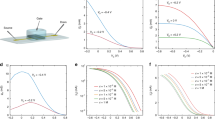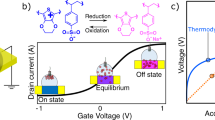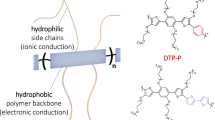Abstract
The use of electrolyte gating to electrically control electronic, magnetic and optical properties of materials has seen strong recent growth, driven by the potential of the many devices and applications that such control may enable. Contrary to initial expectations of a purely electrostatic response based on electron or hole doping, electrochemical mechanisms based on the motion of ions are now understood to be common, suggesting promising new electrical control concepts.
This is a preview of subscription content, access via your institution
Access options
Access Nature and 54 other Nature Portfolio journals
Get Nature+, our best-value online-access subscription
$29.99 / 30 days
cancel any time
Subscribe to this journal
Receive 12 print issues and online access
$259.00 per year
only $21.58 per issue
Buy this article
- Purchase on Springer Link
- Instant access to full article PDF
Prices may be subject to local taxes which are calculated during checkout



Similar content being viewed by others
References
Ahn, C. H., Triscone, J. M. & Mannhart, J. Electric field effect in correlated oxide systems. Nature 424, 1015–1018 (2003).
Ahn, C. H. et al. Electrostatic modification of novel materials. Rev. Mod. Phys. 78, 1185 (2006).
Ramesh, R. & Schlom, D. G. Whither oxide electronics. MRS Bull. 33, 1006–1014 (2008).
Chakhalian, J., Millis, A. J. & Rondinelli, J. M. Whither the oxide interface. Nat. Mater. 11, 92–94 (2012).
Hwang, H. Y. et al. Emergent phenomena at oxide interfaces. Nat. Mater. 11, 103–113 (2012).
Kim, S. H. et al. Electrolyte-gated transistors for organic and printed electronics. Adv. Mater. 25, 1822–1846 (2013).
Fujimoto, T. & Awaga, K. Electric-double-layer field-effect transistors with ionic liquids. Phys. Chem. Chem. Phys. 15, 8983–9006 (2013).
Du, H., Lin, X., Xu, Z. & Chu, D. Electric double-layer transistors: a review of recent progress. J. Mater. Sci. 50, 5641–5673 (2015).
Bisri, S. Z., Shimizu, S., Nakano, M. & Iwasa, Y. Endeavor of iontronics: from fundamentals to applications of ion-controlled electronics. Adv. Mater. 29, 1607054 (2017).
Lodge, T. P. A unique platform for materials design. Science 321, 50–51 (2008).
Ueno, K. et al. Electric-field-induced superconductivity in an insulator. Nat. Mater. 7, 855–858 (2008).
Dhoot, A. S., Israel, C., Moya, X., Mathur, N. D. & Friend, R. H. Large electric field effect in electrolyte-gated managnites. Phys. Rev. Lett. 102, 136402 (2009).
Scherwitzl, R. et al. Electric-field control of the metal-insulator transition in ultrathin NdNiO3 films. Adv. Mater. 22, 5517–5520 (2010).
Yuan, H. et al. Electrostatic and electrochemical nature of liquid-gated electric-double-layer transistors based on oxide semiconductors. J. Am. Chem. Soc. 132, 18402–18407 (2010).
Ueno, K. et al. Discovery of superconductivity in KTaO3 by electrostatic carrier doping. Nat. Nanotech. 6, 408–412 (2011).
Bollinger, A. T. et al. Superconductor–insulator transition inLa2–xSrxCuO4 at the pair quantum resistance. Nature 472, 458–460 (2011).
Leng, X., Garcia-Barriocanal, J., Bose, S., Lee, Y. & Goldman, A. M. Electrostatic control of the evolution from a superconducting to an insulating phase in ultrathin YBa2Cu3O7–x films. Phys. Rev. Lett. 107, 027001 (2011).
Yamada, Y. et al. Electrically induced ferromagnetism at room temperature in cobalt-doped titanium dioxide. Science 332, 1065–1067 (2011).
Nakano, M. et al. Collective bulk carrier delocalization driven by electrostatic surface charge accumulation. Nature 487, 459–462 (2012).
Jeong, J. et al. Suppression of metal-insulator transition in VO2 by electric-field-induced oxygen vacancy formation. Science 339, 1402–1405 (2013).
Li, M. et al. Suppression of ionic liquid gate-induced metallization of SrTiO3(001) by oxygen. Nano Lett. 13, 4675–4678 (2013).
Yi, H. T., Gao, B., Xie, X., Cheong, S.-W. & Podzorov, V. Tuning the metal-insulator crossover and magnetism in SrRuO3 by ionic gating. Sci. Rep. 4, 6604 (2014).
Gallagher, P. et al. A high-mobility electronic system at an electrolyte-gated oxide surface. Nat. Commun. 6, 6437 (2015).
Bubel, S. et al. The electrochemical impact on electrostatic modulation of the metal-insulator transition in nickelates. Appl. Phys. Lett. 106, 122102 (2015).
Walter, J., Wang, H., Luo, B., Frisbie, C. D. & Leighton, C. Electrostatic vs. electrochemical doping and control of ferromagnetism in ion-gel-gated ultrathin La0.5Sr0.5CoO3–δ. ACS Nano 10, 7799–7810 (2016).
Walter, J. et al. Ion-gel-gating-induced oxygen vacancy formation in epitaxial La0.5Sr0.5CoO3–δ films from in operando x-ray and neutron scattering. Phys. Rev. Mater. 1, 071403 (2017).
Perez-Muñoz, A. M. et al. In operando evidence of deoxygenation in ionic liquid gating of YBa2Cu3O7-x. Proc. Natl Acad. Sci. 114, 215–220 (2017).
Dong, Y. et al. Effect of gate voltage polarity on the ionic liquid gating behavior of NdNiO3/NdGaO3 heterostructures. APL Mater. 5, 051101 (2017).
Leng, X. et al. Insulator to metal transition in WO3 induced by electrolyte gating. npj Quantum Mater. 2, 35 (2017).
Walter, J. et al. Giant electrostatic modification of magnetism via electrolye-gate-induced cluster percolation in La1–xSrxCoO3–δ. Phys. Rev. Mater. (in the press); preprint at https://arxiv.org/abs/1807.09364
Schladt, T. D. et al. Crystal-facet-dependent metallization in electrolyte-gated rutile TiO2 single crystals. ACS Nano 7, 8074–8081 (2013).
Xie, W., Wang, S., Zhang, X., Leighton, C. & Frisbie, C. D. High conductance 2D transport around the Hall mobility peak in electrolyte-gated rubrene crystals. Phys. Rev. Lett. 113, 246602 (2014).
Cho, J. H. et al. Printable ion-gel gate dielectrics for low-voltage polymer thin-film transistors on plastic. Nat. Mater. 7, 900–906 (2008).
Wang, S., Ha, M., Manno, M., Frisbie, C. D. & Leighton, C. Hopping transport and the Hall effect near the insulator-metal transition in electrochemically gated poly(3-hexylthiophene) transistors. Nat. Commun. 3, 1210 (2012).
Yajima, T., Nishimura, T. & Toriumi, A. Positive-bias gate-controlled metal-insulator transition in ultrathin VO2 channels with TiO2 gate dielectrics. Nat. Commun. 6, 10104 (2015).
Ji, H., Wei, J. & Natelson, D. Modulation of the electrical properties of VO2 nanobeams using an ionic liquid as a gating medium. Nano Lett. 12, 2988–2992 (2012).
Shibuya, K. & Sawa, A. Modulation of metal-insulator transition in VO2 by electrolyte gating-induced protonation. Adv. Electron. Mater. 2, 1500131 (2016).
Leng, X., Bollinger, A. T. & Bozovic, I. Purely electronic mechanism of electrolyte gating of indium tin oxide thin films. Sci. Rep. 6, 31239 (2016).
Lu, N. et al. Electric-field control of tri-state phase transformation with a selective dual-ion switch. Nature 546, 124–128 (2017).
Shimamura, K. et al. Electrical control of Curie temperature in cobalt using an ionic liquid film. Appl. Phys. Lett. 100, 122402 (2012).
Bi, C. et al. Reversible control of Co magnetism by voltage-induced oxidation. Phys. Rev. Lett. 113, 267202 (2014).
Bauer, U. et al. Magneto-ionic control of interfacial magnetism. Nat. Mater. 14, 174–181 (2015).
Gilbert, D. A. et al. Structural and magnetic depth profiles of magneto-ionic heterostructures beyond the interface limit. Nat. Commun. 7, 12264 (2016).
Lu, Q. et al. Electrochemically triggered metal-insulator transition between VO2 and V2O5. Adv. Funct. Mater. 28, 1803024 (2018).
Ren, X., Frisbie, C. D. & Leighton, C. Anomalous cooling-rate-dependent charge transport in electrolyte-gated rubrene crystals. J. Phys. Chem. Lett. 9, 4828–4833 (2018).
Youssef, M., Van Vliet, K. J. & Yildiz, B. Polarizing oxygen vacancies in insulating metal oxides under a high electric field. Phys. Rev. Lett. 119, 126002 (2017).
Prasad, B. et al. Integrated circuits comprising patterned functional liquids. Adv. Mater. 30, 1802598 (2018).
Acknowledgements
I thank a number of colleagues and collaborators for contributing to my understanding in this area, including D. Frisbie, B. Shklovskii, M. Greven, T. Lodge, A. Goldman, J. Garcia-Barriocanal, J. Walter, H. Wang and X. Ren. Financial support from the University of Minnesota NSF MRSEC (DMR-1420013) and the DOE-supported Center for Quantum Materials (DE-SC-0016371) is acknowledged.
Author information
Authors and Affiliations
Corresponding author
Ethics declarations
Competing interests
The author declares no competing interests.
Additional information
Publisher’s note: Springer Nature remains neutral with regard to jurisdictional claims in published maps and institutional affiliations.
Rights and permissions
About this article
Cite this article
Leighton, C. Electrolyte-based ionic control of functional oxides. Nature Mater 18, 13–18 (2019). https://doi.org/10.1038/s41563-018-0246-7
Received:
Accepted:
Published:
Issue Date:
DOI: https://doi.org/10.1038/s41563-018-0246-7
This article is cited by
-
Realizing metallicity in Sr2IrO4 thin films by high-pressure oxygen annealing
NPG Asia Materials (2023)
-
A clean ballistic quantum point contact in strontium titanate
Nature Electronics (2023)
-
Artificially controlled nanoscale chemical reduction in VO2 through electron beam illumination
Nature Communications (2023)
-
Wide-range continuous tuning of the thermal conductivity of La0.5Sr0.5CoO3-δ films via room-temperature ion-gel gating
Nature Communications (2023)
-
High-strength, stretchable, and self-recoverable copolymer-supported deep eutectic solvent gels based on dense and dynamic hydrogen bonding for high-voltage and safe flexible supercapacitors
Polymer Bulletin (2023)



